Pyromorphite is a secondary lead mineral that forms in the oxidation zones of lead ore deposits. It is classified as a member of the apatite group of phosphates and has the chemical formula Pb5_55(PO4_44)3_33Cl. The mineral is primarily composed of lead (Pb), phosphorus (P), oxygen (O), and chlorine (Cl). Small amounts of arsenic can sometimes substitute for phosphorus in the structure, leading to variations in its composition.
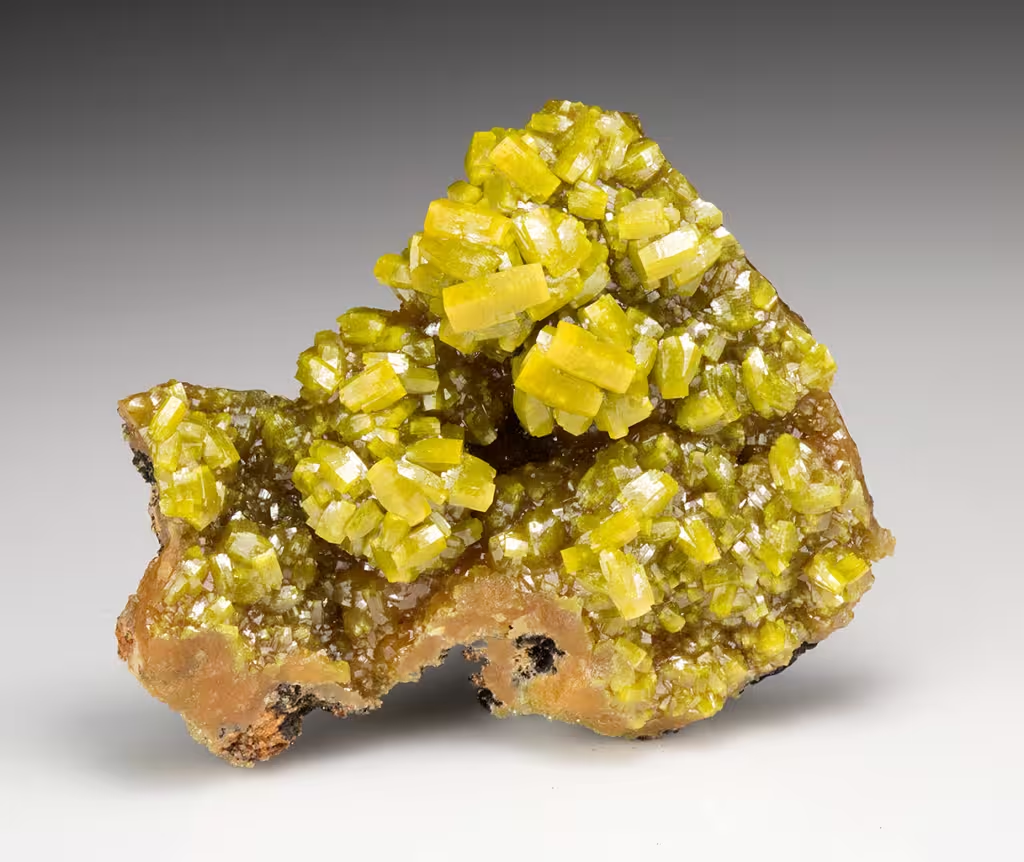
Pyromorphite was first identified in the 18th century, although its recognition as a distinct mineral species came later. The name “pyromorphite” is derived from the Greek words “pyr” (fire) and “morphe” (form), which refers to the mineral’s ability to change form when heated. This name was chosen because early mineralogists observed that pyromorphite crystals could melt and re-solidify into new forms when exposed to high temperatures.
Pyromorphite typically forms as bright, colorful, hexagonal crystals, often with a green, yellow, or brown hue, though orange and white specimens also occur. The mineral has a vitreous to resinous luster, and its crystals are usually short and prismatic, sometimes forming in aggregates or crusts. Pyromorphite has a Mohs hardness of 3.5 to 4, making it relatively soft, and a specific gravity of 6.5 to 7.1, indicating its heavy nature due to the lead content. This mineral is often found in association with other lead minerals like galena and cerussite in lead-rich environments.
Contents
Geological Formation of Pyromorphite
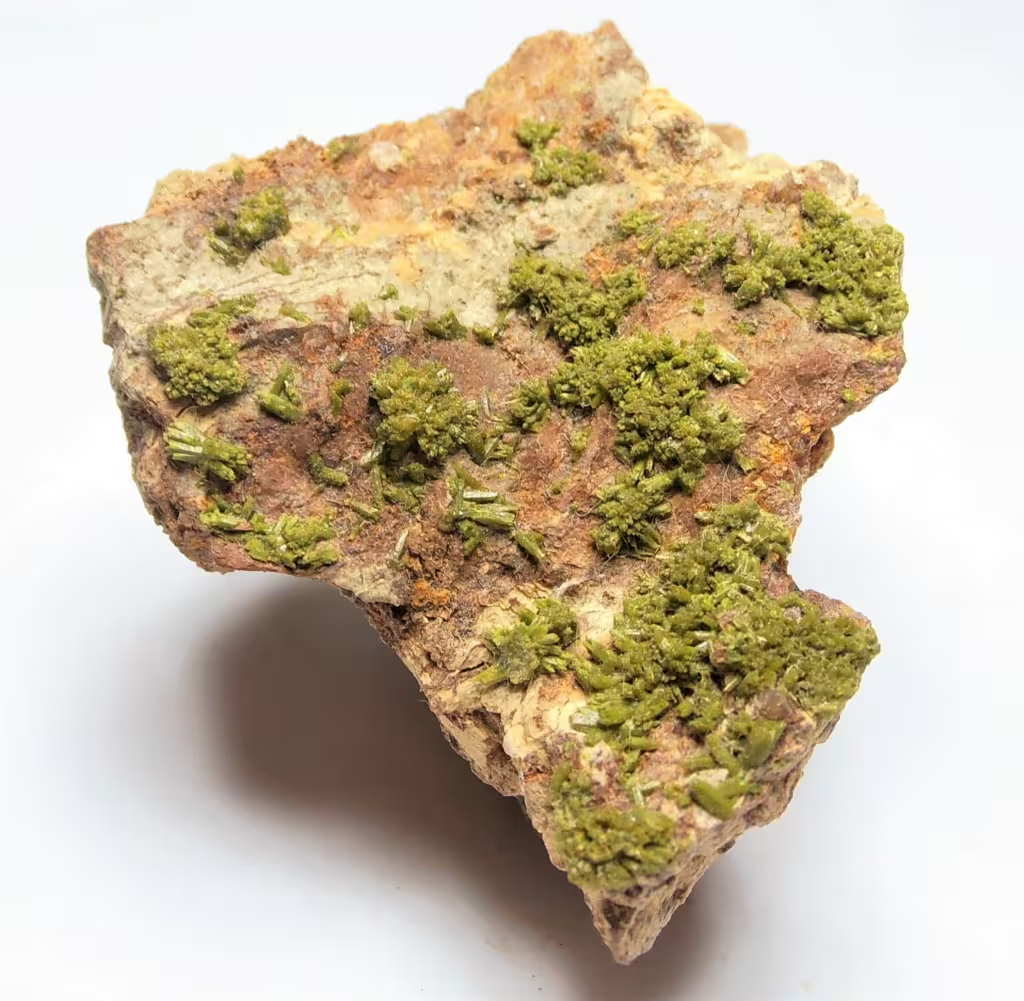
Conditions of Formation: Pyromorphite forms primarily in the oxidation zones of lead ore deposits. These are near-surface environments where primary lead minerals such as galena (PbS) are exposed to oxygen and water. The oxidation process leads to the breakdown of these primary minerals and the formation of secondary minerals like pyromorphite. The presence of phosphate-rich solutions and chlorine is essential for pyromorphite formation, as they provide the necessary chemical components for its crystal structure. These conditions typically arise in areas where groundwater interacts with phosphate-bearing rocks or organic material.
Common Geological Environments: Pyromorphite is commonly found in the upper parts of lead ore veins, particularly in regions with significant weathering and oxidation. It often occurs in old mining dumps or in the oxidized zones of lead mines, where the alteration of primary lead minerals has taken place. These environments are typically rich in secondary minerals, and pyromorphite can be found in cavities, cracks, or as coatings on the surfaces of other minerals.
Association with Other Minerals Pyromorphite is frequently associated with other secondary lead minerals, including:
- Galena (PbS): The primary lead ore, which undergoes oxidation to form secondary minerals like pyromorphite.
- Cerussite (PbCO3_33): A secondary lead carbonate mineral that often occurs alongside pyromorphite in the oxidation zones of lead deposits.
- Anglesite (PbSO4_44): Another secondary lead mineral formed from the oxidation of galena, often found with pyromorphite.
- Mimetite (Pb5_55(AsO4_44)3_33Cl): A mineral closely related to pyromorphite, with arsenate instead of phosphate, which can occur in similar environments.
These minerals often coexist in lead-rich environments, where the chemical conditions favor the formation of a variety of secondary lead minerals. Pyromorphite is also sometimes found with other non-lead minerals like limonite (FeO(OH)·nH2_22O) and quartz (SiO2_22).
Physical and Chemical Properties of Pyromorphite
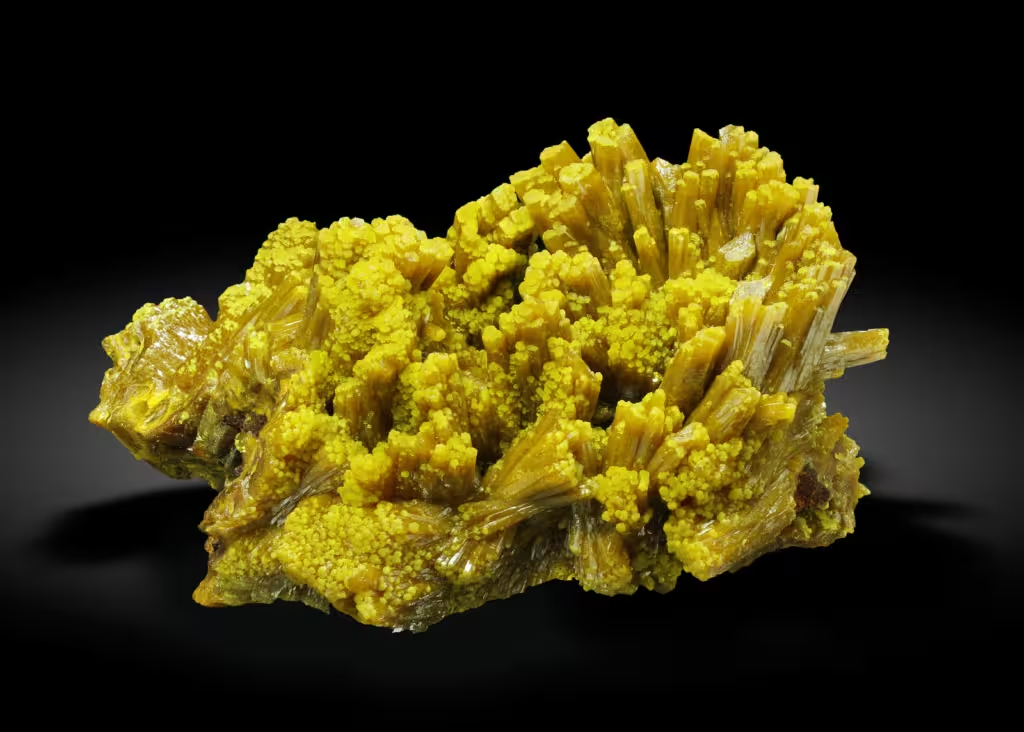
Physical Properties
- Color: Pyromorphite typically displays vibrant colors, most commonly shades of green, yellow, and brown. Less common colors include orange, gray, white, and occasionally pink. The color is influenced by trace elements or impurities within the mineral.
- Crystal System: Hexagonal. Pyromorphite usually forms as short, prismatic hexagonal crystals. These crystals can also appear in radiating, fibrous, or botryoidal (grape-like) aggregates.
- Luster: The luster of pyromorphite ranges from vitreous (glass-like) to resinous, contributing to its bright and attractive appearance.
- Hardness: Pyromorphite has a Mohs hardness of 3.5 to 4, which makes it relatively soft. This means it can be scratched by harder materials such as quartz.
- Specific Gravity: The specific gravity of pyromorphite is high, typically between 6.5 and 7.1. This high density is due to its significant lead content, making it feel heavy for its size.
- Cleavage: Pyromorphite has poor to indistinct cleavage, meaning it does not break along well-defined planes.
- Fracture: The fracture of pyromorphite is typically uneven to sub-conchoidal (curved surfaces similar to glass), which can result in sharp edges when broken.
- Transparency: Pyromorphite ranges from transparent to translucent, depending on the thickness and quality of the crystal.
- Streak: The streak of pyromorphite (the color of its powder) is white.
Chemical Properties
- Chemical Formula: Pb5_55(PO4_44)3_33Cl
- Composition: Pyromorphite is primarily composed of lead (Pb), phosphorus (P), oxygen (O), and chlorine (Cl). The general composition includes:
- Lead (Pb): ~76.4%
- Phosphorus (P): ~7.1%
- Oxygen (O): ~16.3%
- Chlorine (Cl): ~2.4%
- Solubility: Pyromorphite is generally insoluble in water but can be slightly soluble in strong acids due to its phosphate content.
- Reactivity: Pyromorphite is relatively stable under normal environmental conditions. However, when exposed to high temperatures, it may alter or melt, which relates to its name, as “pyromorphite” references its ability to change form when heated.
- Substitutions and Variations: In some cases, arsenic can substitute for phosphorus in pyromorphite’s crystal structure, leading to the formation of mimetite (Pb5_55(AsO4_44)3_33Cl) or a solid solution series between pyromorphite and mimetite. This can result in variations in color and other properties.
These physical and chemical properties make pyromorphite an attractive mineral for collectors, particularly due to its bright colors, crystal forms, and association with other interesting minerals.
Occurrence and Distribution of Pyromorphite
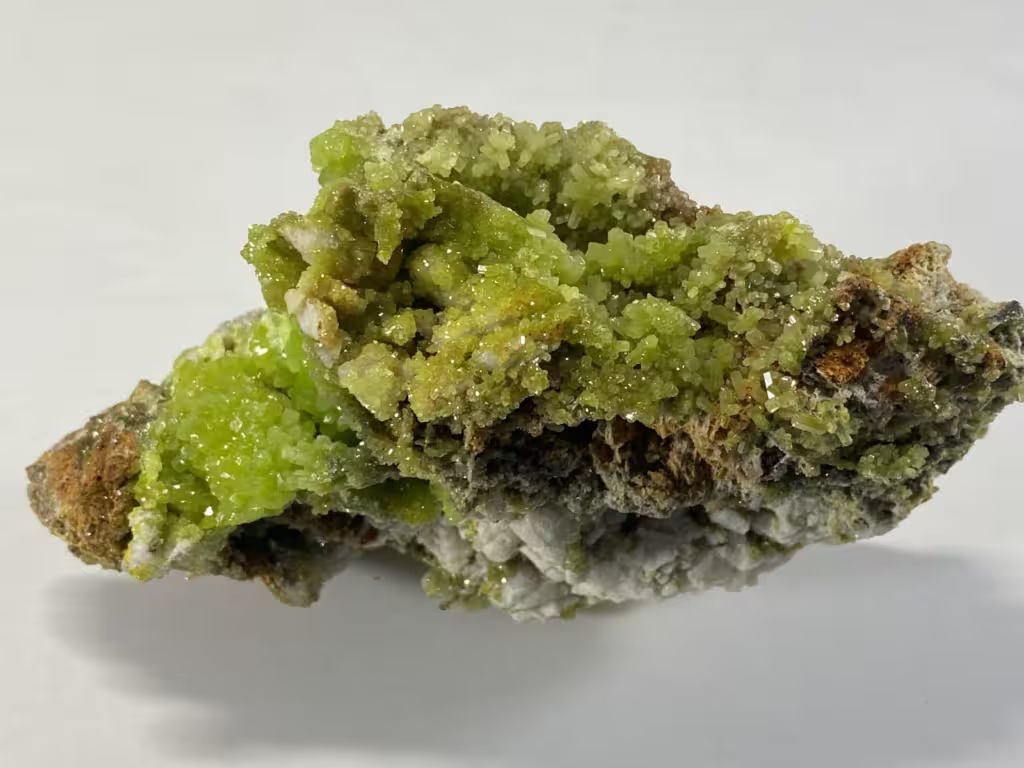
Occurrence
Pyromorphite is a secondary mineral that typically forms in the oxidized zones of lead ore deposits. These environments are where primary lead sulfide minerals, such as galena (PbS), undergo chemical weathering and oxidation. The mineral forms when lead is released from the decomposition of these primary minerals and then reacts with phosphate-bearing solutions, leading to the crystallization of pyromorphite.
The formation of pyromorphite is favored in environments where there is a combination of lead, phosphate, and chloride-rich conditions. These environments are often found near the surface in regions with significant historical or ongoing weathering processes. It can occur as well-formed crystals, encrustations, or in massive forms, often associated with other secondary minerals like cerussite, anglesite, and mimetite.
Distribution
Pyromorphite is found in many lead mining regions worldwide, with notable occurrences in several countries. Some of the most significant localities include:
- Europe:
- Germany: The Harz Mountains and Saxony are famous for producing some of the finest pyromorphite specimens, particularly from the Bad Ems and the Friedrichssegen mines.
- France: Pyromorphite is found in various localities, including the Huelgoat and Pontgibaud areas. The Les Farges mine in Corrèze is particularly known for its high-quality specimens.
- United Kingdom: The Mendip Hills in Somerset and the Caldbeck Fells in Cumbria have produced notable pyromorphite crystals, particularly in old lead mining areas.
- North America:
- United States: Significant occurrences are found in Idaho, particularly in the Coeur d’Alene district, which is famous for its bright green pyromorphite crystals. Other notable localities include Pennsylvania (Phoenixville district) and New Mexico (Bunker Hill mine).
- Mexico: Pyromorphite has been found in several locations, including the mines of Chihuahua and Durango.
- Asia:
- China: In recent years, China has become a significant source of pyromorphite, with large, well-formed crystals coming from mines in the Guangxi and Yunnan provinces.
- Australia:
- Broken Hill, New South Wales: This famous mining region has produced pyromorphite, often in association with other secondary lead minerals like cerussite and anglesite.
- Africa:
- Morocco: The Mibladen mining district is known for producing pyromorphite crystals, often found alongside vanadinite.
These locations demonstrate the global distribution of pyromorphite, particularly in regions with a history of lead mining. The mineral is highly valued by collectors for its vibrant colors, well-formed crystals, and the variety of forms it can take, making these localities well-known within the mineral collecting community.
Economic and Industrial Importance of Pyromorphite

Economic Importance
Pyromorphite, as a secondary lead mineral, has limited direct economic importance compared to primary lead ores like galena. However, it holds some significance in specific contexts:
- Indicator of Lead Ore Deposits: Pyromorphite often occurs in the oxidation zones of lead ore deposits. Its presence can indicate the proximity of primary lead minerals like galena, which are economically valuable. In some cases, the identification of pyromorphite can guide further exploration and mining activities, leading to the discovery of more significant lead resources.
- Mineral Specimen Trade: Pyromorphite is highly sought after by mineral collectors due to its vibrant colors, well-formed crystals, and rarity in high-quality specimens. As a result, it has a niche economic value in the mineral specimen market. Well-crystallized specimens from famous localities can fetch high prices among collectors and dealers, making it a valuable commodity in the context of the geological and mineralogical hobbyist community.
Industrial Importance
Pyromorphite does not have direct industrial applications, primarily due to the following reasons:
- Lead Content: While pyromorphite contains a high percentage of lead, it is not commonly processed as an ore for lead extraction. The mineral occurs in relatively small quantities compared to primary lead minerals like galena, making it uneconomical to use as a lead ore on an industrial scale.
- Processing Challenges: The presence of phosphate in pyromorphite complicates the extraction and refining of lead. The phosphate content would require additional processing steps to separate the lead from the phosphate, increasing costs and reducing the feasibility of using pyromorphite as a lead source.
Environmental Considerations
In modern times, the environmental and health concerns associated with lead mining and processing have reduced the focus on minerals like pyromorphite for industrial use. Lead is a toxic metal, and efforts are being made to minimize its use and manage its environmental impact. Pyromorphite, due to its stability and relative insolubility, is not typically a direct environmental hazard. However, its formation can signal areas where lead contamination might be an issue, particularly in old mining regions.
Summary
While pyromorphite itself is not of major economic or industrial importance, it plays a role as an indicator of lead deposits and has value in the mineral specimen market. Its significance is more aligned with geological exploration and mineral collection rather than large-scale industrial applications.
Collecting and Valuation of Pyromorphite
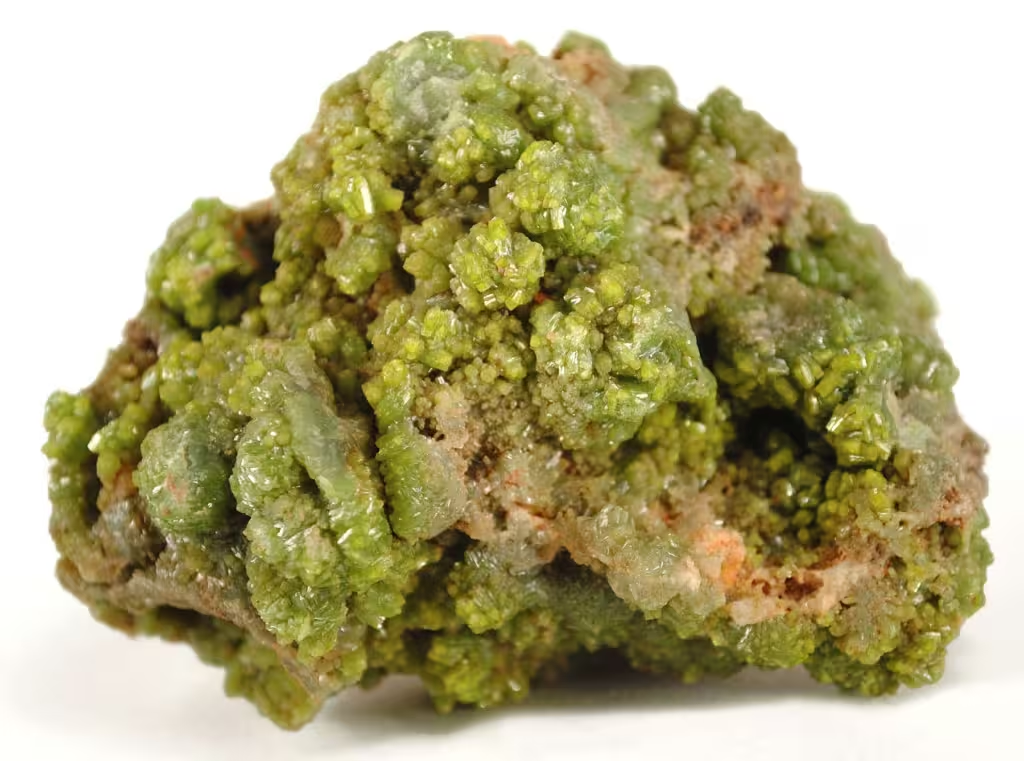
Collecting Pyromorphite
Pyromorphite is a highly prized mineral among collectors due to its striking colors, well-formed crystals, and relative rarity. When collecting pyromorphite, several factors contribute to its desirability and value:
- Color: The color of pyromorphite is one of its most attractive features. Specimens with bright, vivid colors—especially greens, yellows, and oranges—are the most sought after. Unusual colors, such as pink or gray, can also be of interest to collectors due to their rarity.
- Crystal Form: Well-formed, sharp hexagonal crystals are highly valued. Prismatic crystals with good termination, as well as specimens with a unique crystal habit (e.g., botryoidal or radiating aggregates), are particularly desirable. The larger and more well-defined the crystals, the higher the value.
- Luster: A vitreous to resinous luster enhances the visual appeal of pyromorphite. Specimens with a high luster are generally more valuable.
- Size: The size of the specimen plays a significant role in its valuation. Larger crystals or clusters of crystals are typically more valuable, especially when combined with good color and form. However, small but exceptionally well-formed and brightly colored crystals can also be highly prized.
- Association with Other Minerals: Specimens that feature pyromorphite in association with other minerals, such as galena, cerussite, or anglesite, can be particularly interesting to collectors. These associations can provide a more complete picture of the mineral’s geological context and can add to the specimen’s overall aesthetic and scientific value.
- Provenance: The origin of a pyromorphite specimen can significantly impact its value. Specimens from famous or historically significant localities (e.g., Bad Ems in Germany, Coeur d’Alene in Idaho, or Les Farges in France) are often more valuable. Provenance can also affect the perceived rarity of a specimen.
Valuation of Pyromorphite
The value of a pyromorphite specimen is determined by several factors:
- Rarity: Specimens from rare localities or with unusual characteristics (e.g., color or crystal form) command higher prices. For example, pyromorphite from less accessible or now-depleted localities can be particularly valuable.
- Quality: High-quality specimens with vibrant color, excellent crystal form, and good luster are valued more highly. Specimens with damage, poor color, or dull luster are less desirable and thus less valuable.
- Size and Aesthetics: Larger, well-formed, and visually striking specimens generally fetch higher prices. Aesthetic appeal, which is often subjective, plays a critical role in determining a specimen’s value. A piece that stands out due to its beauty or uniqueness is likely to be valued more highly.
- Market Demand: Like other collectibles, the market demand for pyromorphite can fluctuate. Trends in the mineral collecting community, the discovery of new deposits, or the depletion of old ones can influence prices. High demand for certain localities or colors can drive up prices.
Examples of Valuation:
- Small, Common Specimens: Small pyromorphite crystals from well-known localities can range from $20 to $100, depending on their quality and color.
- Medium to Large, High-Quality Specimens: Well-formed crystals with vibrant color from famous localities can range from $200 to several thousand dollars, especially if the specimen is large and aesthetically pleasing.
- Exceptional Specimens: Rare and high-quality pyromorphite specimens, particularly those with unique colors, crystal forms, or provenance, can sell for tens of thousands of dollars in the mineral specimen market.
Summary
Collecting pyromorphite is an endeavor that rewards those with an eye for quality, rarity, and beauty. The mineral’s vibrant colors, crystal forms, and the reputation of its localities all contribute to its desirability and value among collectors. While prices can vary widely based on these factors, high-quality specimens from notable localities consistently command the highest prices in the market.




































